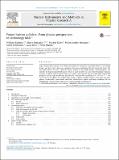Future hadron colliders: From physics perspectives to technology R&D
Author(s)
Battaglia, Marco; Klute, Markus; Mangano, Michelangelo; Prestemon, Soren; Rossi, Lucio; Skands, Peter; Barletta, William A.; ... Show more Show less
DownloadKlute_Future hadron.pdf (3.133Mb)
PUBLISHER_CC
Publisher with Creative Commons License
Creative Commons Attribution
Terms of use
Metadata
Show full item recordAbstract
High energy hadron colliders have been instrumental to discoveries in particle physics at the energy frontier and their role as discovery machines will remain unchallenged for the foreseeable future. The full exploitation of the LHC is now the highest priority of the energy frontier collider program. This includes the high luminosity LHC project which is made possible by a successful technology-readiness program for Nb[subscript 3]Sn superconductor and magnet engineering based on long-term high-field magnet R&D programs. These programs open the path towards collisions with luminosity of 5×10[superscript 34] cm[superscript −2] s[superscript −1] and represents the foundation to consider future proton colliders of higher energies. This paper discusses physics requirements, experimental conditions, technological aspects and design challenges for the development towards proton colliders of increasing energy and luminosity.
Date issued
2014-07Department
Massachusetts Institute of Technology. Department of PhysicsJournal
Nuclear Instruments and Methods in Physics Research Section A: Accelerators, Spectrometers, Detectors and Associated Equipment
Publisher
Elsevier
Citation
Barletta, William, Marco Battaglia, Markus Klute, Michelangelo Mangano, Soren Prestemon, Lucio Rossi, and Peter Skands. “Future Hadron Colliders: From Physics Perspectives to Technology R&D.” Nuclear Instruments and Methods in Physics Research Section A: Accelerators, Spectrometers, Detectors and Associated Equipment 764 (November 2014): 352–368. © 2015 CERN for the benefit of the Authors.
Version: Final published version
ISSN
01689002